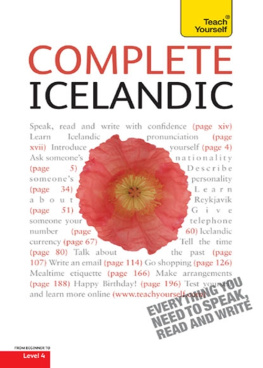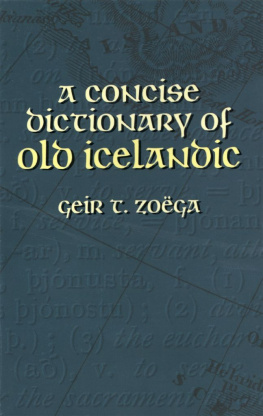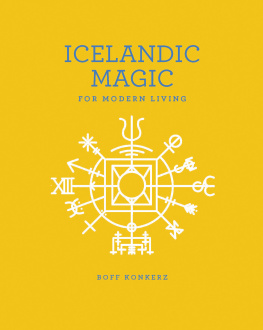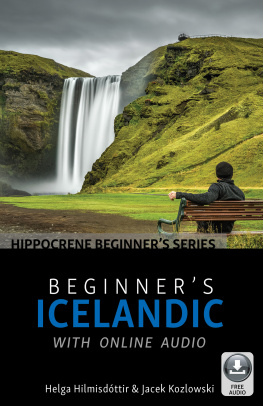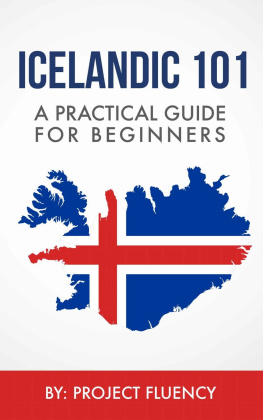

Contents

Meet the author
I have a BA degree from the University of Iceland and an M.Phil. degree in general linguistics from the University of Cambridge, England, where I also taught beginners courses in Icelandic for two years. I was awarded the Henrik Steffens grant for a years study in Germany from the Alfred Toepfer Institute FVS, Hamburg. As a freelance translator I have performed assignments for Icelandic and foreign translation agencies and a number of private enterprise companies, translating in various fields, including tourism, advertising, administration and business. Since 2007 I have run my own translation agency in Iceland which undertakes translating and editing, mainly texts from English and German into Icelandic.
Hildur Jnsdttir
1 Only got a minute?
Icelandic is the official language of Iceland, a large country of 103,000 km with just over 300,000 inhabitants.
Two-thirds of the population live in or near the capital, Reykjavik, in the southwest. Icelandic, like Norwegian, Swedish, Danish and Faroese, belongs to the Nordic language group of the Germanic language family. Iceland was settled in the period ad 870930 by Vikings mostly from Norway, especially Western Norway. In the eleventh century Icelandic and Norwegian began to diverge, and two centuries later there was a clear distinction between the two languages. Icelandic has not changed greatly through the centuries. The main changes have been in the phonetic system, especially of vowels, with little effect on the written language.
The inflectional system and syntax have undergone fewer changes. Most of the old Icelandic vocabulary, such as hann (he), hs (house), sj (see), still exists in the modern language. New words are generally formed by connecting older words and word parts together in a new way: for example, from the words lf (life) and fri (science) the word lffri (biology) was formed. There are, however, many loanwords in the language which have been adapted to Icelandic pronunciation, spelling and inflection. The word bll, for example, is a loanword from Danish. Other loanwords in Icelandic include banani (banana), kaffi (coffee) and te (tea).
The survival of the written language has played an important part in conserving the language. Laws were written in Icelandic at the beginning of the twelfth century, and the Icelandic sagas date from the thirteenth and fourteenth centuries. A translation of the New Testament into Icelandic was printed in 1540, followed by the whole Bible in 1584. The best-known modern Icelandic author is undoubtedly Halldr Laxness (19021998), winner of the Nobel Prize for literature in 1955. 
5 Only got five minutes?
Icelandic is the official language in Iceland, a country of just over 300,000 people. Iceland is a large country, of 103,000 km, but two-thirds of the population live in the capital, Reykjavik, and surrounding towns in the southwest of the country.
People live only around the coastline, as the middle of the country is uninhabitable with arctic deserts, glaciers, mountains and volcanoes (usually dormant). The west, north and east coasts have many fjords, creeks and coves. In geothermal areas in Iceland there are many geysers and hot springs. The most famous of these is the Great Geysir in southwest Iceland, which first erupted in the fourteenth century and from which the English word geyser is derived. When it erupts it shoots a jet of steaming water to heights of up to 70 metres. There are numerous waterfalls in Iceland, the most famous being Gullfoss (Golden Waterfall) in the river Hvt in the southwest, and Dettifoss, Europes most powerful waterfall, in the glacial river Jkuls in northeastern Iceland.
The glacier Vatnajkull (Glacier of Lakes) in southeast Iceland is the biggest glacier in Europe and covers about 8% of the country. The climate in Iceland is mild, due to the warm Gulf Stream that flows along the south coast of the country and then continues west and north along the coast. The winters are fairly warm and the summers fairly cool. The Northern Lights (Aurora Borealis) can frequently be seen in Iceland from September through March. In midwinter (mid-November to the end of January) the days are very short and there is daylight for only three to four hours a day. In the summer, on the other hand, there is continuous daylight for two to three months and the days are long in early spring and autumn.
Icelandic belongs to the Nordic language group of the Germanic language family, together with the other Scandinavian languages, Norwegian, Swedish, Danish and Faroese. Icelandic, Faroese and Norwegian are West Nordic languages and Swedish and Danish are East Nordic languages. Iceland was settled in the period ad 870930. Most of the settlers came from Norway, especially Western Norway, with a few from Sweden and Denmark and from Nordic settlements in the British Isles (Ireland, Scotland and the Scottish Isles). The Norsemen from the British Isles brought with them people of Celtic origin. The language in Iceland was, however, Old Norse from the outset and the Celtic influence on the language is limited to a few loanwords and names of people and places.
Among the Celtic peoples names that have survived to the present day are Kjartan, Njll and Kormkur. Icelandic and Norwegian began to diverge in the eleventh century, but the distinction between the two languages was not fully marked until about two centuries later. Icelandic has not changed greatly throughout the centuries and can be classified as a conservative language. Modern Icelandic is very similar to the Viking language, and speakers of modern Icelandic can read the sagas, which were written in the thirteenth and fourteenth centuries, without any great difficulty. The main changes have been in the phonetic system, especially of vowels, with little effect on the written language. The inflectional system, syntax and vocabulary have undergone fewer changes.
Most of the old Icelandic vocabulary still exists in the modern language. Many common words in modern Icelandic are the same as in Old Norse, words such hfu (head), (you), haf (sea). Many idioms and phrases from old Icelandic literature are still used in everyday language today, such as koma einhverjum opna skjldu (to take someone by surprise), which translates literally as to come at someone on the side that isnt protected by their shield. Words have been gradually added to the language over the centuries and some older words have been given new meanings alongside their old ones. Some old words have been revived and given a new meaning. The word smi (telephone
Next page
